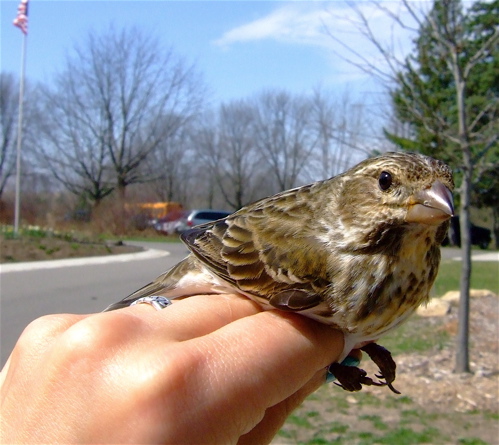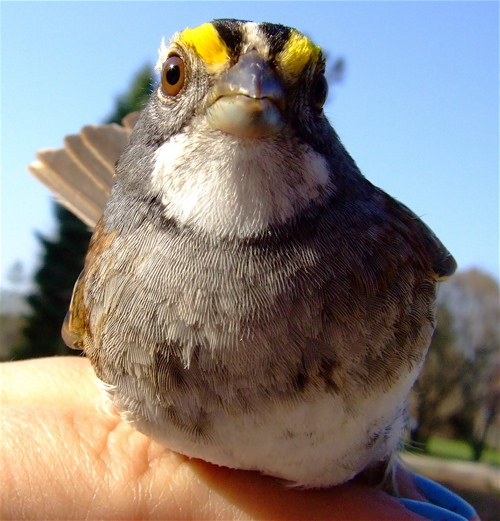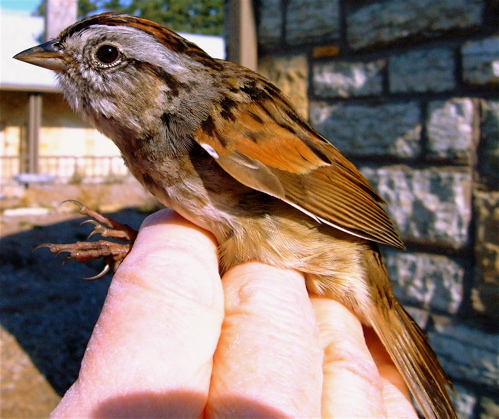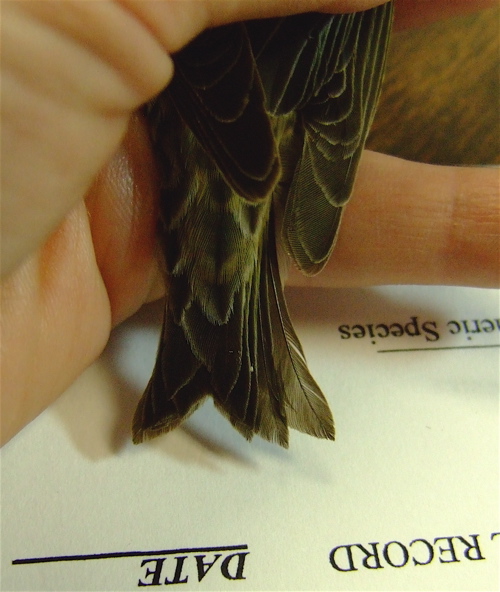 It was a busy day of banding brown birds at Carpenter Nature Center last Friday. Above is a female purple finch that flew into the nets. It was interesting to not the changing of the guard we had going on migration wise.
It was a busy day of banding brown birds at Carpenter Nature Center last Friday. Above is a female purple finch that flew into the nets. It was interesting to not the changing of the guard we had going on migration wise.
Although, the first bird I banded was not a migrant, but a house sparrow. I know this is a non native species and they can wreak havoc with bluebird and purple martin nest boxes, but the males in breeding plumage are a very striking bird. Check out that jet black bill. If you are not familiar with house sparrows in the US, they were brought over from Europe. House sparrows are cavity nesters and will aggressively compete with our native birds (like bluebirds, wrens, tree swallows, chickadees, nuthatches and purple martins) for nest holes. If a house sparrow wants an already taken nest cavity, they will use that thick and pointy bill to attack whoever is already in there. They will peck a hole in the back of the heads of the adult or young birds and even build their own nest on top of the carcasses. I once found a freshly dead white-breasted nuthatch on a birding trail. It had a hole in the back of its head. I looked straight up from where the nuthatch was on the ground and saw a small cavity in the tree trunk with a house sparrow poking its head out.
But the most common sparrow we banded last Friday were white-throated sparrows. Yikes, the way that white-throated sparrow looks in the above photo, I think he roughed up poor Sam Peabody. It was funny, the Friday previous we had nothing but juncos, however a week later there were absolutely no juncos and tons of white-throats. These guys are on their way to Canada for nesting, but watch for them foraging for millet under your bird feeders.
Here was fun sparrow that we weren't expecting--a swamp sparrow. The last time I saw one of these guys was at Cape May, NJ last October. Incidentally, these sparrows have the longest legs of any other sparrow in the US, most likely to help with foraging in water in a swamp.
Here's another sparrow that is a spring favorite for me--a field sparrow. They have one of the best bird songs out there. Check out how long this bird's tail is. Many of the birds we banded had longish tails.
It kind of threw me when we got in some pine siskins and they barely have a tail at all. They were so stubby, just something I had not noticed until they were in hand.
Here's an up close view of the little stub tail. Many of us had big numbers of pine siskins this winter and I've heard through the Minnesota birding grapevine that some are already building nests in Minnesota.
Above is our banding crew at Carpenter. If you'd like to watch our banding, we open it to the public every fourth Friday of the month. Although, we band every Friday so if you're at Carpenter on a Friday morning, you'll see us milling around, checking nets.
This Saturday, you can watch my buds Mark Newstrom and Roger Everhart at Lowry Nature Center as part of the Youth Birding Clinic. It’s geared for kids between the ages of 10 - 19 and includes bird banding, forest bird hikes, grassland bird hikes, wetland bird hikes, a session on digital photography, and birding by bike. I’ll even give a presentation on techno birding. All sessions take place at Lowry Nature Center. You need to register for the event, so call 763-559-6700.









